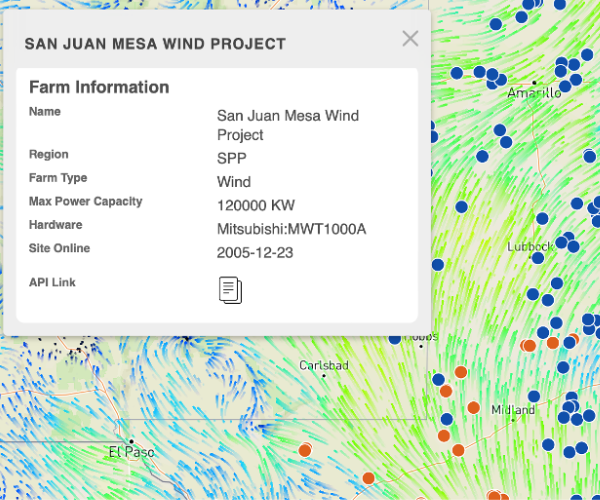Our weather API is renowned for its breadth of data, available from over 40 endpoints and easily manipulated with our multitude of parameters and filters. One of these datasets is what we refer to as “solrad,” or solar radiation. Solar radiation refers to electromagnetic radiation emitted by the sun.
Over the years our team of scientists and engineers have put a lot of time into improving how our solar radiation data is calculated and collected. In December of 2023 we brought a version 2.0 of our solrad calculations out of beta, with enhancements to our sunrise/sunset timeframes, improvements to the atmospheric components of our various solrad calculations, and more.
Our weather API solrad datapoints include:
Solar Azimuth Angle and Solar Zenith Angle, both calculated using standard formulas based on time and latitude/longitude
Global Horizontal Irradiance (GHI), Direct Normal Irradiance (DNI), and Diffused Horizontal Irradiance (DHI), each calculated based on factors like solar position, air temperature, pressure, and cloud cover. GHI is also reported directly by some observation stations.
One noteworthy example of solrad data in action can be found in solar energy farm applications. The position and tilt of solar panels is critical to ensuring that they capture as much energy from the sun as possible. Thanks to our data, solar energy companies can know the precise position of the sun as well as the amount of radiation it is putting off at any given location.
In this post, we will discuss both the meaning of these measurement units and how they can be used.
What solrad data does the weather API provide?
Let’s start by covering our solar radiation measurements — specifically, the datapoints available through the conditions endpoint within the solrad response object. These values are derived from data ingested and run through our own proprietary algorithms to improve hyperlocal accuracy.
azimuthDEG: The solar azimuth angle, referring to a horizontal coordinate which defines the sun’s relative direction along the local horizon. This data is critical for solar farms to optimize their energy output by ensuring panels face directly into the sun.
zenithDEG: The solar zenith angle, referring to the angle between the local zenith (directly above the point on the ground) and the line of sight from that point to the sun. Solar zenith angle is typically used in combination with solar azimuth angle to determine the position of the sun as observed from a given location on the surface of the earth.
ghiWM2: This is the estimated 1-hour Global Horizontal Irradiance (global solar radiation), which is the sum of Direct Normal Irradiation and Diffused Horizontal Irradiation in watts/meter squared. This is considered a fundamental source of information in industries like water resource management and renewable energy generation.
dniWM2: The estimated 1-hour Direct Normal Irradiation, which is the amount of solar radiation from the direction of the sun, in watts/meter squared. This data is of particular relevance in concentrating solar thermal plans and concentrated photovoltaic systems.
dhiWM2: The estimated 1-hour Diffused Horizontal Irradiance, which is the radiation at the Earth’s surface from light scattered by the atmosphere, in watts/meter squared. This data is often used to improve tracking techniques for solar photovoltaic panels
What makes this data unique?
As a part of the industry-leading Vaisala family, our solar radiation offerings include all of this with the following benefits thanks to the powerful minds behind the data:
Our cloud coverage forecasts are based on high-resolution models and interpolated down to a 100m resolution
Our conditions endpoint leverages an array of sources and analyses, including satellite information, real-time mesoscale analysis, and ground truth observations to provide accurate cloud coverage, temperature, and pressure values — critical components in our solar radiation modeling
In 2023, Vaisala acquired the French company SoDa — or Solar Radiation Data — a leader in providing historical, real-time, and forecast solar radiation and related weather data services, further advancing the quality of solrad data we’re able to provide
Accessing solrad datasets with the Weather API
Xweather’s solrad data can be retrieved from three of our API endpoints by passing filters and parameters to obtain just the solrad data of interest. Below are examples for accessing each of them:
conditions:
https://data.api.xweather.com/conditions/minneapolis,mn?plimit=1&filter=1min&fields=periods.dateTimeISO,periods.solrad&client_id=[client_id]&client_secret=[client_secret]
forecasts:
https://data.api.xweather.com/forecasts/minneapolis,mn?plimit=1&filter=1min&fields=periods.dateTimeISO,periods.solradWM2,periods.solradMinWM2,periods.solradMaxWM2,periods.solradClearSkyWM2&client_id=[client_id]&client_secret=[client_secret]
observations/summary:
https://data.api.xweather.com/observations/summary/PWS_B102019?fields=periods.dateTimeISO,periods.summary.solrad&client_id=[client_id]&client_secret=[client_secret]Note: Most weather stations do not report solrad information. When this happens, the response data for solrad will appear as “null.”
The many applications and use cases of solrad data make it one of the most vital datasets we provide — from site prospecting to photovoltaic power plant design and general safety. Test out this robust dataset and myriad others with a free developer trial or reach out to our team of experts to discuss solrad integrations for your business today.

